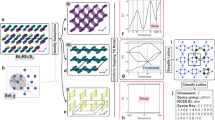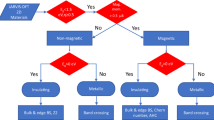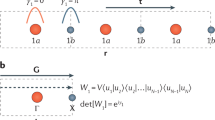Abstract
Topological electronic flattened bands near or at the Fermi level are a promising route towards unconventional superconductivity and correlated insulating states. However, the related experiments are mostly limited to engineered materials, such as moiré systems1,2,3. Here we present a catalogue of the naturally occuring three-dimensional stoichiometric materials with flat bands around the Fermi level. We consider 55,206 materials from the Inorganic Crystal Structure Database catalogued using the Topological Quantum Chemistry website4,5, which provides their structural parameters, space group, band structure, density of states and topological characterization. We combine several direct signatures and properties of band flatness with a high-throughput analysis of all crystal structures. In particular, we identify materials hosting line-graph or bipartite sublattices—in either two or three dimensions—that probably lead to flat bands. From this trove of information, we create the Materials Flatband Database website, a powerful search engine for future theoretical and experimental studies. We use the database to extract a curated list of 2,379 high-quality flat-band materials, from which we identify 345 promising candidates that potentially host flat bands with charge centres that are not strongly localized on the atomic sites. We showcase five representative materials and provide a theoretical explanation for the origin of their flat bands close to the Fermi energy using the S-matrix method introduced in a parallel work6.
This is a preview of subscription content, access via your institution
Access options
Access Nature and 54 other Nature Portfolio journals
Get Nature+, our best-value online-access subscription
$29.99 / 30 days
cancel any time
Subscribe to this journal
Receive 51 print issues and online access
$199.00 per year
only $3.90 per issue
Buy this article
- Purchase on Springer Link
- Instant access to full article PDF
Prices may be subject to local taxes which are calculated during checkout


Similar content being viewed by others
Data availability
All data are available in the Supplementary Information and through our public website, the Materials Flatband Database (https://www.topologicalquantumchemistry.fr/flatbands).
Change history
08 July 2022
A Correction to this paper has been published: https://doi.org/10.1038/s41586-022-05065-6
References
Bistritzer, R. & MacDonald, A. H. Moiré bands in twisted double-layer graphene. Proc. Natl Acad. Sci. USA 108, 12233–12237 (2011).
Cao, Y. et al. Unconventional superconductivity in magic-angle graphene superlattices. Nature 556, 43–50 (2018).
Cao, Y. et al. Correlated insulator behaviour at half-filling in magic-angle graphene superlattices. Nature 556, 80–84 (2018).
Vergniory, M. G. et al. A complete catalogue of high-quality topological materials. Nature 566, 480–485 (2019).
Vergniory, M. G. et al. All topological bands of all stoichiometric materials. Preprint at https://arxiv.org/abs/2105.09954 (2021).
Călugăru, D. et al. General construction and topological classification of crystalline flat bands. Nat. Phys. 18, 185–189 (2022).
Kumar, P., Peotta, S., Takasu, Y., Takahashi, Y. & Törmä, P. Flat-band-induced non-Fermi-liquid behavior of multicomponent fermions. Phys. Rev. A 103, L031301 (2021).
Tsui, D. C., Stormer, H. L. & Gossard, A. C. Two-dimensional magnetotransport in the extreme quantum limit. Phys. Rev. Lett. 48, 1559–1562 (1982).
Laughlin, R. B. Anomalous quantum Hall effect: an incompressible quantum fluid with fractionally charged excitations. Phys. Rev. Lett. 50, 1395–1398 (1983).
Moore, G. & Read, N. Nonabelions in the fractional quantum Hall effect. Nucl. Phys. B 360, 362–396 (1991).
Drozdov, A., Eremets, M., Troyan, I., Ksenofontov, V. & Shylin, S. I. Conventional superconductivity at 203 kelvin at high pressures in the sulfur hydride system. Nature 525, 73–76 (2015).
Drozdov, A. et al. Superconductivity at 250 K in lanthanum hydride under high pressures. Nature 569, 528–531 (2019).
Tang, E., Mei, J.-W. & Wen, X.-G. High-temperature fractional quantum Hall states. Phys. Rev. Lett. 106, 236802 (2011).
Neupert, T., Santos, L., Chamon, C. & Mudry, C. Fractional quantum Hall states at zero magnetic field. Phys. Rev. Lett. 106, 236804 (2011).
Sheng, D., Gu, Z.-C., Sun, K. & Sheng, L. Fractional quantum Hall effect in the absence of Landau levels. Nat. Commun. 2, 389 (2011).
Regnault, N. & Bernevig, B. A. Fractional Chern insulator. Phys. Rev. X 1, 021014 (2011).
Balents, L., Dean, C. R., Efetov, D. K. & Young, A. F. Superconductivity and strong correlations in moiré flat bands. Nat. Phys. 16, 725–733 (2020).
Peri, V., Song, Z.-D., Bernevig, B. A. & Huber, S. D. Fragile topology and flat-band superconductivity in the strong-coupling regime. Phys. Rev. Lett. 126, 027002 (2021).
Rhim, J.-W., Kim, K. & Yang, B.-J. Quantum distance and anomalous Landau levels of flat bands. Nature 584, 59–63 (2020).
Xie, F., Song, Z., Lian, B. & Bernevig, B. A. Topology-bounded superfluid weight in twisted bilayer graphene. Phys. Rev. Lett. 124, 167002 (2020).
Peotta, S. & Törmä, P. Superfluidity in topologically nontrivial flat bands. Nat. Commun. 6, 8944 (2015).
Bradlyn, B. et al. Topological quantum chemistry. Nature 547, 298–305 (2017).
Y. Xu et al. Filling-enforced obstructed atomic insulators. Preprint at https://arxiv.org/abs/2106.10276 (2021).
Mielke, A. Exact ground states for the Hubbard model on the kagome lattice. J. Phys. A 25, 4335–4345 (1992).
Tasaki, H. From Nagaoka’s ferromagnetism to flat-band ferromagnetism and beyond: an introduction to ferromagnetism in the Hubbard model. Prog. Theor. Phys. 99, 489–548 (1998).
Bergman, D. L., Wu, C. & Balents, L. Band touching from real-space topology in frustrated hopping models. Phys. Rev. B 78, 125104 (2008).
Liu, Z., Liu, F. & Wu, Y.-S. Exotic electronic states in the world of flat bands: from theory to material. Chin. Phys. B 23, 077308 (2014).
Ma, D.-S. et al. Spin–orbit-induced topological flat bands in line and split graphs of bipartite lattices. Phys. Rev. Lett. 125, 266403 (2020).
Chiu, C. S., Ma, D.-S., Song, Z.-D., Bernevig, B. A. & Houck, A. A. Fragile topology in line-graph lattices with two, three, or four gapped flat bands. Phys. Rev. Res. 2, 043414 (2020).
Inorganic Crystal Structure Database (ICSD) (Fachinformationszentrum Karlsruhe, 2015); https://icsd.products.fiz-karlsruhe.de/.
Hohenberg, P. & Kohn, W. Inhomogeneous electron gas. Phys. Rev. 136, B864–B871 (1964).
Kohn, W. & Sham, L. J. Self-consistent equations including exchange and correlation effects. Phys. Rev. 140, A1133–A1138 (1965).
Kresse, G. & Hafner, J. Ab initio molecular dynamics for open-shell transition metals. Phys. Rev. B 48, 13115–13118 (1993).
Kresse, G. & Furthmüller, J. Efficiency of ab-initio total energy calculations for metals and semiconductors using a plane-wave basis set. Comput. Mater. Sci. 6, 15–50 (1996).
Ivantchev, S., Kroumova, E., Madariaga, G., Pérez-Mato, J. M. & Aroyo, M. I. SUBGROUPGRAPH: a computer program for analysis of group–subgroup relations between space groups. J. Appl. Crystallogr. 33, 1190–1191 (2000).
Ivantchev, S. et al. SUPERGROUPS—a computer program for the determination of the supergroups of the space groups. J. Appl. Crystallogr. 35, 511–512 (2002).
Souza, I., Marzari, N. & Vanderbilt, D. Maximally localized Wannier functions for entangled energy bands. Phys. Rev. B 65, 035109 (2001).
Acknowledgements
We thank X. Dai, D. Calugaru, A. Chew, M. Vergniory and C. Chiu for discussions. We acknowledge the computational resources Cobra/Draco in the Max Planck Computing and Data Facility (MPCDF) and Atlas in the Donostia International Physics Center (DIPC). This research also used the resources of the National Energy Research Scientific Computing Center (NERSC), a US Department of Energy Office of Science User Facility operated under contract number DE-AC02-05CH11231. This work is part of a project that has received funding from the European Research Council (ERC) under the European Union’s Horizon 2020 research and innovation programme (grant agreement number 101020833). B.A.B. and N.R. were also supported by the US Department of Energy (grant number DE-SC0016239), and were partially supported by the National Science Foundation (EAGER grant number DMR 1643312), a Simons Investigator grant (number 404513), the Office of Naval Research (ONR grant number N00014-20-1-2303), the Packard Foundation, the Schmidt Fund for Innovative Research, the BSF Israel US foundation (grant number 2018226), the Gordon and Betty Moore Foundation through grant number GBMF8685 towards the Princeton theory programme, and a Guggenheim Fellowship from the John Simon Guggenheim Memorial Foundation. A.Y., N.P.O., R.J.C., L.M.S., B.A.B. and N.R. were supported by the NSF-MRSEC (grant number DMR-2011750). A.Y. was supported by NSF-DMR-1904442. B.A.B., L.M.S. and N.R. acknowledge financial support from the Schmidt DataX Fund at Princeton University made possible through a major gift from the Schmidt Futures Foundation. L.M.S. acknowledges financial support from the Packard and Sloan Foundation. L.E. was supported by the Government of the Basque Country (Project IT1301-19) and the Spanish Ministry of Science and Innovation (PID2019-106644GB-I00). C.F. was supported by the European Research Council (ERC) advanced grant number 742068 ‘TOP-MAT’, Deutsche Forschungsgemeinschaft (DFG) through SFB 1143, and the Würzburg-Dresden Cluster of Excellence on Complexity and Topology in Quantum Matter-ct.qmat (EXC 2147, project number 390858490). S.S.P.P. acknowledges funding by the Deutsche Forschungsgemeinschaft (DFG, German Research Foundation)—project number 314790414.
Author information
Authors and Affiliations
Contributions
B.A.B. and N.R. conceived this work; N.R. and M.-R.L. performed the high-throughput calculations with the help from L.E. and Y.X.; Y.X., D.-S.M., Z.-D.S., M.-R.L., L.E. and N.R. worked out the theoretical explanations for the flat-band materials detailed in Supplementary Section F; the material lists in Supplementary Section H were manually selected by Y.X., M.-R.L., Z.-D.S., M.J. and N.R.; N.R. built the flat-band material database; D.-S.M. performed the ab initio ferromagnetic calculations advised by Y.X.; M.J., L.S. and C.F. helped curate the list of materials to find the most experimentally relevant. All authors discussed the results and wrote the main text and Methods; Y.X., Z.-D.S., M-.R.L., D.-S.M., M.J., L.E. and N.R. wrote the Supplementary Information.
Corresponding authors
Ethics declarations
Competing interests
The authors declare no competing interests.
Peer review
Peer review information
Nature thanks David Carpentier and the other, anonymous, reviewer(s) for their contribution to the peer review of this work. Peer reviewer reports are available.
Additional information
Publisher’s note Springer Nature remains neutral with regard to jurisdictional claims in published maps and institutional affiliations.
Supplementary information
Supplementary Information
This file contains supplementary text, equations, tables, figures and references.
Rights and permissions
About this article
Cite this article
Regnault, N., Xu, Y., Li, MR. et al. Catalogue of flat-band stoichiometric materials. Nature 603, 824–828 (2022). https://doi.org/10.1038/s41586-022-04519-1
Received:
Accepted:
Published:
Issue Date:
DOI: https://doi.org/10.1038/s41586-022-04519-1
This article is cited by
-
Tuning of the flat band and its impact on superconductivity in Mo5Si3−xPx
Nature Communications (2024)
-
Crystal net catalog of model flat band materials
npj Computational Materials (2024)
-
Hopping frustration-induced flat band and strange metallicity in a kagome metal
Nature Physics (2024)
-
Flat bands, strange metals and the Kondo effect
Nature Reviews Materials (2024)
-
Non-Fermi liquid behaviour in a correlated flat-band pyrochlore lattice
Nature Physics (2024)
Comments
By submitting a comment you agree to abide by our Terms and Community Guidelines. If you find something abusive or that does not comply with our terms or guidelines please flag it as inappropriate.



